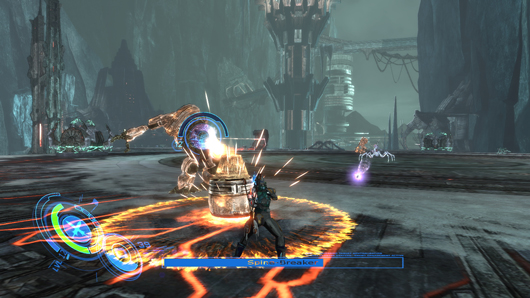There are occasions when it is difficult to immediately recognize a game’s greatness without first allowing it to unfold and reveal its entire composition. Such games often deliver the most satisfying experience to players who opt to explore the content thoroughly and completely.
Silicon Knights’ Too Human is that sort of game. This is a piece of software that, like works of literature or film, takes time to develop into something truly praiseworthy. The simply enjoyable combat mechanics evolve into a complex system of character specification, inventory management and equipment customization shift from secondary pursuits into a unified, comprehensive craft, and the storyline grows ever more captivating as the game progresses.

Too Human treads the uncommon path of incorporating Norse mythology and 19th-century philosophy into a tale about a technologically advanced civilization of mortal humans and a cybernetically enhanced society of “gods” called the Aesir. The collective group finds itself locked in bitter warfare with an encroaching machine race, and the Aesir are tasked with protecting the population from being harvested by these bloodthirsty sentients.
Serving as the first act in a planned trilogy, Too Human‘s climax is more the delivery of an intriguing plot point concerning the protagonist (Baldur) than an actual peak in the story’s action, and resolution is non-existent; the game ends in a sequel-setting cliffhanger. Despite these shortcomings, however, Too Human is a highly captivating beginning to an epic and meaningful tale about the ills of transhumanism. Wonderfully directed cutscenes and carefully interwoven flashback sequences tie together the action of the core gameplay very well.

Too Human‘s graphical presentation is not jaw-dropping in a technical sense, but the cinematography, artistic direction, and environment design work together to present players with awe-inspiring scenes, conveying a sense of magnitude that ties directly into the game’s plot. The camera is carefully positioned nearly every step of the way, showing players a world exactly as the developers wanted it to be seen. This is a crafted experience, and the static-yet-mobile camera (much like that of Eternal Darkness) provides the angles necessary to make it so. The drawback to this approach is that players have almost no control over their field of view, which occasionally makes combat and navigation more cumbersome than one might like.
For the most part, Too Human captures players in a flow of gameplay that keeps them engaged consistently throughout the experience. Combat is simple enough to carry out using the basic attack mechanics of the right analog stick–push the stick in the direction of the enemy you would like to attack–but also features enough complexities (battle cries, spider abilities, ruiner attacks) to keep players interested as their skills with the system improve. Even dying (the frequency of which depends on the player, class, skill tree specs, etc.) amounts to only a momentary lapse in the game’s action and a degradation of equipped items (until repaired). This means that consequences of death are kept in the virtual world rather than being artificially applied to the player’s interactive experience with the game.

This seamlessness doesn’t go unbroken throughout the entire game, however. Players will gather a massive amount of loot during their quest, and may subsequently spend a great deal of time managing equipment in the inventory menu. New weapons, armor, rune augmentations, blueprints, etc. will all demand attention if the player’s character is to grow, especially in the early-goings. Unwanted items must be salvaged to gain bounty (the game’s currency), and manually checking equipment and selling it off can be a time-consuming affair. Luckily, there is an auto-salvage feature that automatically trades in items based on a tiered “rarity scale,” ditching low-quality equipment without concerning the player. This significantly eases the burden of inventory management, even though it is to a certain degree inescapable.
Too Human is an incredibly customizable experience. In addition to the full sets of armor, various weapon types, equipment tweaks, runes, charms, etc., the game’s five distinct classes each demand a different approach to gameplay. The Berserker, Defender, Champion, Commando, and Bioengineer each have heavily weighted strengths and weaknesses, unique skills, proficiencies, and equipment. Each one also has a three-path class skill tree and a two-path alignment skill tree, which players must allocate points to as they gain levels. The opposing paths on each tree are mutually exclusive, meaning that committing to one path will forfeit the abilities found in the other(s). This also means that there are essentially 30 different types of characters (builds) to be played in Too Human, with more alleged to arrive later as downloadable content. The game’s story remains the same regardless of character choice.

In the online two-player cooperative mode, class and build characteristics play an important role for party synergy as players travel through cutscene-free and plotless campaign levels, rack up experience points, and collect loot. Partnering characters that compliment one another allows players to successfully vanquish foes together. For example, the offensive prowess of a Berserker combined with the restorative abilities of a Bioengineer would make for a deadly team. Characters from the game’s single-player campaign can be used online, and vice-versa, with all equipment and experience carrying over from one mode to the other. Players can revisit all areas in the single-player game, as well.
Too Human is not for everyone; its gameplay style and/or narrative themes may turn some gamers away before they can even jump into Asgard. The game is, however, a triumph in everything it aims to do. It tells [the beginnings of] an intriguing story through breathtaking cinematography and narrative, introduces a unique and effective combat system, and allows players to personalize their gameplay experience with an extensive amount of customization options. This is an excellent videogame.

















